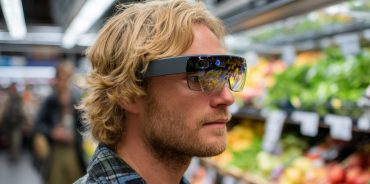A look back at my 2021 retail predictions
Following the global upheaval we faced in 2020, 2021 was meant to be the year when we get back to ‘normal’. Unfortunately, if normal meant going back to the way things were pre-covid, that day never really felt like it arrived.
However, it was far from a lost year. We vaccinated over half of the world’s population, SpaceX launched the first all civilian space flight, and we flew a helicopter on Mars! Perhaps I should have been more ambitious with my 2021 predictions.
As we have done over the past several years, we like to look back at the predictions made at the start of the year to see which ones came true and which didn’t quite live up to their promise. Here are the trends we thought would be having the biggest impact on food and grocery retail in 2021:
Prediction 1: Data privacy-as-a-service
Here is what we said: As a growing number of countries introduce their own laws and requirements to deal with data processing, this nascent field may become an increasingly effective solution for businesses without the data governance framework needed to keep ahead of that curve.
A quick recap on what DPaaS is: it offers exactly what the name implies – providing organisations with a way to outsource their data protection responsibilities to a third party. This can enable businesses to remain compliant in the face of rapidly changing data protection legislation.
And rapidly changing this legislation is. Twenty-three US states have introduced new data privacy legislation in 2021 and in August, China introduces their Personal Information Protection Law. Needless to say, the pace of new regulation has certainly not slowed down and doesn’t look likely to do so any time soon. This, combined with continued changes by Google and Apple to put privacy at the forefront of the user experience, has created further demand for data privacy focused startups.
Some of those startups include SkyFlow, who raised an additional $45m, Laminar, who raised $32m, and Inrupt, who raised $30m in new funding. We expect this space to continue to accelerate into 2022.
Prediction 2: Rise of the dark kitchen
Here is what we said: Producing food for the sole purpose of home delivery, dark kitchens have provided numerous restaurant chains with a way to cater to the demands of customers who have found themselves unable – or unwilling – to venture to a dine-in location.
Also known as Ghost Kitchens or Cloud Kitchens, this trend has continued to accelerate, partially driven by the demand created by the next hour commerce players like DoorDash, Uber, and Deliveroo.
In a move beyond my 2021 prediction, we’ve seen the delivery companies themselves stepping up, with DoorDash opening a kitchen to make meals for six restaurants in San Jose, California, working with restaurant brands to learn how to cook their food, recreate their supply chains, and secure the chefs, on top of providing the usual marketing and delivery services.[1]
As the demand for food delivery expands globally with pace, the rise of dark kitchens ensures that customers who return to dine-in receive a great restaurant experience, unaffected by a surge in online orders.
Prediction 3: More CPG Brands go Direct to Consumer
Here is what we said: The idea of a brands going direct to their Customers isn’t a new one. Why, then, might 2021 be the year in which direct to consumer (DTC) gathers significant momentum? DTC is about more than just a commercial response to the pandemic; selling direct to the end Customer also gives brands the opportunity to develop a much deeper relationship with that person – something that can prove invaluable in terms of the insights and understanding gained as a result.
2021 was undoubtedly another bumper year for ecommerce. With fewer customers in-store, many retailers expanded their DTC operations, with sports brand Nike now making nearly $45 billion from its 40% DTC business, with targets of $50 billion in 2022.[2]
And although some DTC brands expanded during the pandemic (Peloton, HelloFresh and Barkbox all excelled), we also saw a shift in the opposite direction. Many of the original DTC brands like Casper and Allbirds are now diversifying and selling through wholesalers and in-store.[3] The majority of grocery brands have also focused on in-store, but whichever direction brands take with DTC in 2022, it’s likely not to be a one-way street.
Prediction 4: Virtual queuing helps Retailers go with the flow
Here is what we said: Today, with stores under huge pressure to manage the flow of customers for social distancing, virtual queuing is likely to see increased take-up in the months ahead. Whether it’s allowing shoppers to collect their goods from a contactless pickup location, or simply giving them the option to stay warm while waiting their turn to enter a store, virtual queuing gives Retailers a range of ways to improve the quality of the experience while also keeping their Customers safe.
When social distancing and virus control was at its peak, many retailers trialed virtual queueing tech. In the UK, Lidl rolled out tech helping shoppers visit at quieter times, while Asda went a step further and allowed customers to book a specific in-store shopping slot.[4]
With restrictions now slowly lifting in many countries, grocery retailers have been keen to get people back into stores without barriers, resulting in much of this queuing tech already being retired. However, virtual queueing has continued to work well for luxury brands who have smaller stores and customers who want more personal service.
Virtual queuing hasn’t just benefited the customer. It’s now becoming the norm at amusement parks like Disneyland[5], where guests can reserve their spot in the virtual queue for any given ride, freeing them to wander around gift shops and food and drink concessions, giving them another opportunity to part with their cash.
A year of change
If 2020 was the year that was impossible to predict, 2021 did at least bring a little more certainty. The Covid pandemic has continued to irreversibly change the way that people shop, and for retailers and brands, the need to innovate at pace has simply become second nature.
As I sit down to write my retail predictions for 2022 later this week, the one certainty is that in the world of retail, nothing stands still for long. But I am optimistic that we can expect a more stable year for our industry as we slowly emerge the other side of the pandemic – I’ve got my fingers crossed.
References
[1] https://qz.com/2039684/doordash-is-launching-ghost-kitchens-to-make-food-for-restaurants/
[2] https://www.retaildive.com/news/these-traditional-brands-are-shifting-to-a-dtc-model-heres-how/607646/
[3] https://www.businessoffashion.com/briefings/retail/warby-parker-allbirds-and-why-dtc-brands-still-cant-scale-profitably/
[4] https://www.insider-trends.com/how-5-retailers-are-changing-the-way-we-queue/
[5] https://www.undercovertourist.com/blog/disneyland-virtual-queue/
TOPICS
RELATED PRODUCTS
Amplify Customer understanding to create strategies that drive results
Customer First solutionsThe latest insights from our experts around the world
AI and data science in 2026: the trends everyone’s talking about



